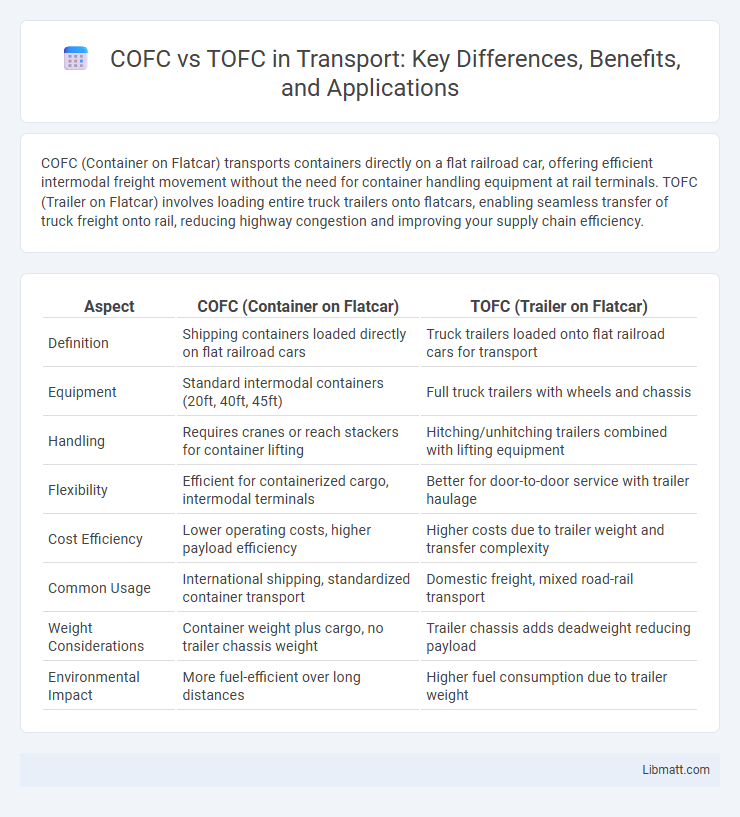COFC (Container on Flatcar) transports containers directly on a flat railroad car, offering efficient intermodal freight movement without the need for container handling equipment at rail terminals. TOFC (Trailer on Flatcar) involves loading entire truck trailers onto flatcars, enabling seamless transfer of truck freight onto rail, reducing highway congestion and improving your supply chain efficiency.
Table of Comparison
| Aspect | COFC (Container on Flatcar) | TOFC (Trailer on Flatcar) |
|---|---|---|
| Definition | Shipping containers loaded directly on flat railroad cars | Truck trailers loaded onto flat railroad cars for transport |
| Equipment | Standard intermodal containers (20ft, 40ft, 45ft) | Full truck trailers with wheels and chassis |
| Handling | Requires cranes or reach stackers for container lifting | Hitching/unhitching trailers combined with lifting equipment |
| Flexibility | Efficient for containerized cargo, intermodal terminals | Better for door-to-door service with trailer haulage |
| Cost Efficiency | Lower operating costs, higher payload efficiency | Higher costs due to trailer weight and transfer complexity |
| Common Usage | International shipping, standardized container transport | Domestic freight, mixed road-rail transport |
| Weight Considerations | Container weight plus cargo, no trailer chassis weight | Trailer chassis adds deadweight reducing payload |
| Environmental Impact | More fuel-efficient over long distances | Higher fuel consumption due to trailer weight |
Introduction to COFC and TOFC
Container on Flatcar (COFC) and Trailer on Flatcar (TOFC) are two intermodal freight transport methods that enhance efficiency by combining rail and truck transportation. COFC involves loading shipping containers directly onto flat railcars, optimizing space and reducing handling time, while TOFC transports entire truck trailers on flatcars, preserving the flexibility of road delivery. Both methods significantly reduce highway congestion and carbon emissions by leveraging the energy efficiency of rail transport for long-haul segments.
Definition of COFC (Container on Flat Car)
COFC (Container on Flat Car) refers to the intermodal transport method where shipping containers are loaded directly onto flat railroad cars without additional trailers. This efficient mode maximizes cargo space utilization and reduces handling since containers remain intact throughout rail transport. COFC is widely used in global logistics for seamless transfer between sea, rail, and land transport systems.
Definition of TOFC (Trailer on Flat Car)
TOFC (Trailer on Flat Car) refers to the transportation method where highway trailers are loaded directly onto flat railcars for efficient intermodal shipping. This process allows your trailers to be moved over long distances by rail while preserving the trailer's contents and structure. TOFC enhances freight logistics by combining rail's fuel efficiency with the flexibility of highway trailers.
Key Differences Between COFC and TOFC
COFC (Container on Flatcar) and TOFC (Trailer on Flatcar) differ primarily in cargo type and equipment: COFC transports standard intermodal containers, while TOFC carries entire truck trailers. COFC maximizes container handling efficiency and is widely used in international shipping, whereas TOFC offers flexibility by integrating trucking and rail, aiding efficient door-to-door delivery. Your choice between COFC and TOFC impacts logistics strategy, cost management, and transit times based on containerization needs.
Advantages of COFC
Container on Flatcar (COFC) offers significant advantages such as reduced handling times and enhanced cargo security by directly transporting containers on railcars without unloading cargo. COFC maximizes container capacity per train, lowering transportation costs and environmental impact due to greater fuel efficiency compared to Truck on Flatcar (TOFC). This method also supports seamless intermodal transfers, improving logistical efficiency for long-distance freight movement.
Advantages of TOFC
TOFC (Trailer on Flatcar) offers significant advantages such as reduced handling and faster transit times compared to COFC (Container on Flatcar) by allowing entire truck trailers to be transported without unloading cargo. This method improves supply chain efficiency by minimizing the need for loading and unloading pallets or containers, which decreases labor costs and damage risks. TOFC also enhances flexibility for intermodal transport, facilitating seamless transitions between road and rail modes in freight logistics.
Cost Comparison: COFC vs TOFC
Cost comparison between COFC (Container on Flat Car) and TOFC (Trailer on Flat Car) highlights that COFC generally offers lower transportation expenses due to simpler handling and reduced equipment requirements. TOFC involves higher costs as it requires specialized chassis and handling for trailers, increasing operational complexity and fees. Choosing COFC can optimize Your logistics budget by minimizing freight charges and handling costs in intermodal shipping.
Operational Efficiency and Flexibility
COFC (Container on Flatcar) offers higher operational efficiency by enabling rapid loading and unloading of standard containers directly onto rail flatcars, reducing handling time and minimizing cargo damage. TOFC (Trailer on Flatcar) provides greater flexibility by allowing entire truck trailers to be transported without unloading cargo, accommodating diverse trailer sizes and simplifying door-to-door logistics. Both methods optimize intermodal transport but COFC excels in speed and cargo security, while TOFC ensures versatile connectivity across multiple transport modes.
Environmental Impact: COFC vs TOFC
Container On Flatcar (COFC) and Trailer On Flatcar (TOFC) both offer significant environmental benefits by reducing highway congestion and lowering greenhouse gas emissions. COFC typically achieves greater fuel efficiency and lower emissions per ton-mile due to the use of standardized containers that optimize cargo space and reduce handling time. TOFC, while also environmentally favorable compared to truck-only transport, tends to have slightly higher emissions because it carries entire trailers with chassis, increasing weight and aerodynamic drag.
Choosing the Right Mode: COFC or TOFC?
Choosing the right intermodal transport mode between COFC (Container on Flat Car) and TOFC (Trailer on Flat Car) depends on your cargo type and handling preferences. COFC is ideal for standardized containers, offering better protection and streamlined loading with cranes, while TOFC suits trailers with preloaded goods, facilitating easier door-to-door logistics and quicker transfers. Your decision should factor in efficiency, cost, and the specific requirements of your shipment to optimize transit performance.
COFC vs TOFC Infographic

 libmatt.com
libmatt.com